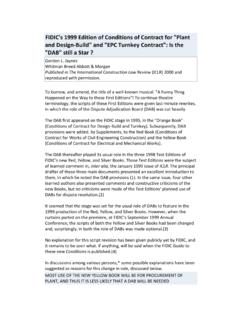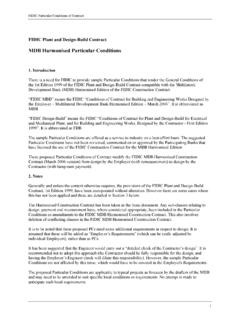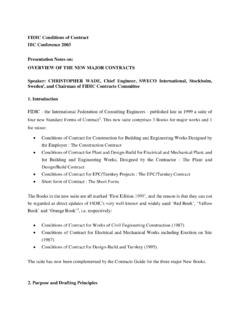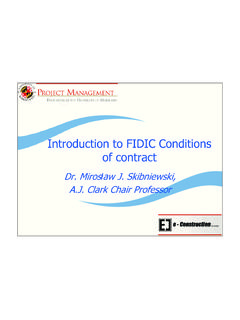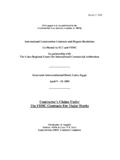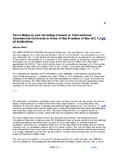Transcription of Limitations of liability in construction contracts - …
1 IHLC onstructionIHLJune 2003 Iain Murdoch looks at different ways in which liability canbe limited in a construction contract and analyses approachestaken in some of the standard forms currently availableIain Murdoch is a solicitor in the construction and engineering department at Speechly Bircham30 Limitations of liability in construction contractsonstruction projects often runover budget and/or programmeand the contract will determinewhich party takes clients and contractors areincreasingly aware of the nature of the risksassociated with their projects and bothstandard form and bespoke contractsaddress allocation of risk in more and more detail. Various factors will affect the allocationof each risk, including political issues, the availability and economics of insurancecover, commercial bargaining power and the nature of the individual project.
2 Often, a party is prepared to take a risk only if it knows its exposure is not open-ended, and limitation of liability is frequentlyaccepted as going hand in hand withapportionment of risk. This briefing looks at how liability can be limited in English law construction contracts (and particularlysome of the standard forms) and at what is, and is not, acceptable in the eyes of the caps on liabilityCommercially, a total cap on liability is the best way for a contractor to limit its total exposure. Some standard formconstruction contracts , particularly thoseused in the plant and process sector, contain express caps on the total loss which may be recovered from the example: The total liability of the Contractor to theEmployer, under or in connection with theContract other than under [Electricity, Water and Gas], Sub-Clause [Employer s Equipment andFree-Issue Material], Sub-Clause [Indemnities] and Sub-Clause [Intellectual and Industrial PropertyRights], shall not exceed the sum statedin the Particular Conditions or (if a sum isnot so stated) the contract Price stated inthe contract Agreement.
3 (FIDIC Conditions of contract forEPC/Turnkey Projects extract fromclause )FIDIC (the International Federation ofConsulting Engineers) holds the view, inrecommending terms for turnkey contracts ,that there should be a total limitation on thecontractor s liabilities, which can be agreedat any level by the parties if they so wish,but otherwise will default to the contractprice. FIDIC also recommends that certainspecific risks are not subject to this cap. Ofthose identified above, third-partyindemnities and intellectual propertyinfringement claims are commonly foundoutside such a new ACE (Association of ConsultingEngineers) suite of engineers appointmentsalso provides for a total cap on liability , asdoes the RIBA (Royal Institute of BritishArchitects) standard form of architect sappointment: In any action or proceedings broughtagainst the architect under or inconnection with the Agreement whether incontract, negligence, tort or howsoever theArchitect s liability for loss or damage inrespect of any one occurrence or series ofoccurrences arising out of one event shallbe limited the stated in (RIBA SFA/99, condition )CIHL111 construction (F) p30-32 2/6/03 9.
4 44 am Page 3031 The maximum liability of the architect is to be an agreed sum. This is also the level of insurance which the architect agrees to carry. Perhaps given the link toinsurance, RIBA has drafted an each andevery claim limitation, such that anarchitect s total liability for separate anddistinct breaches or acts of negligence issubject to the agreed cap in each and everycase, rather than of this nature prevent a partysuccessfully claiming damages in full forlosses suffered. Without contractuallimitations, recovery would be limited onlyby the financial means (perhapsstrengthened by insurance or third-partyguarantee backing) of a defendant (subjectalways to the general rules as torecoverability of damages).Simplistically, such clauses work againstthe client as the potential claimant.
5 So whydo clients accept them? First, if a contractis, by its very nature, high-risk, then withoutsome way of capping its liability , a well-advised contractor or consultant may not beprepared to take on all the risks. Secondly, acontract which clearly allocates risk butwhich limits a consultant or contractor sliability for those risks may be moreeconomic to take on (even with a contractorpricing for risks allocated to it), resulting in alower cost to the client. An example of thisoccurs in most PFI projects, where thepublic sector will usually wish to pass all ofthe construction risk to the private gives a benefit in terms of certainty andresponsibility but, in return, the risktransferred will usually be capped. This willnormally be a requirement of theconstruction company, which may often findthat the capital cost of the project actuallyexceeds its balance lossOther forms of limitation relate to types ofloss and typically have one particular aim to exclude consequential losses.
6 It isconsequential losses which may be the most unpredictable and, on certain projects, the most significant. Whatconstitutes consequential loss will dependupon the circumstances. Often, those whorefer to consequential loss are particularlykeen to exclude loss of profit, but the courts have held that loss of profit may be a direct loss, at least in some definition in the contract , the courts generally allow claims for directlosses to be all those arising naturally from the breach of contract (see Hadley v Baxendale and British Sugar v NEI Power Projects).An example of a limitation clause is thefollowing, giving the parties the ability to capcertain types of losses at an agreedmaximum: .. the Contractor s liability for loss of use,loss of profit or other consequential lossarising in respect of the liability of theContractor in clause [Contractor sdesign liability ] shall be limited to theamount, if any, named in Appendix (JCT Standard Form of Building Contractwith Contractor s Design, 1998 edition extract from clause )This clause addresses loss of profitseparately but does not limit the client sright to claim damages for direct losses for remedying defects in the building sdesign and/or construction .
7 Likewise, ifconstruction (rather than design) works werenot completed in accordance with thecontract, the losses of the client incompleting those works could berecoverable, whatever their nature andvalue, subject to the usual common lawrules and the remainder of the , where a design defect means thatthe client cannot use its new building, orthat a lucrative opportunity to make a profithas been lost, loss of use and/or loss ofprofit claims would succeed only up to theamount of any agreed well as simply adding certainty in thesense of being able to judge the worst-case scenario under the contract for thecontractor and the best-case recovery forthe client if things do go wrong, this draftingis also influenced by the availability ofinsurance at economic levels against risks ofthis types of losses which may be limitedare those arising from delays.
8 The JCT (JointContracts Tribunal) clause above alsoprovides that any liquidated and ascertaineddamages payable by the contractor for delayare not affected by the cap. Such liability isdealt with by reference to the date forcompletion with late completion (subject toextensions of time) allowing the client toclaim such damages at the pre-calculatedrate. The existence of an agreed contractuallevel of damages for late completion, at afixed rate, can also act as a limitation of thecontractor s liability . Large plant and PFIconstruction contracts will, typically, containa separate overall cap on delay agreement clausesEntire agreement clauses are included toprovide for certainty in the terms of thecontract. After a long negotiation, it may bein both parties interests to agree that certainterms and conditions alone define theirrelationship.
9 Parties do not want to be liablefor statements or initial predictions whichare not incorporated in the contract . It isimperative in contracts containing such aclause to be sure that all key terms and keydocuments are included or expressly referredto. The following is a typical clause: The contract constitutes the entireagreement between the Purchaser and theContractor with respect to theperformance of the Works and supersedesall prior negotiations, representations oragreements relating thereto, whetherwritten or oral, except to the extent thatthey are expressly incorporated in theContract. No changes, alterations ormodifications to the contract shall beeffective unless the same shall be inwriting and signed by both parties. (IChemE Red Book, third edition, Article 2.)Whilst there are conflicting views as towhether such a clause is a limitation orexclusion clause in the strict sense, there areclearly circumstances where the effect ofsuch a clause, if enforceable, will be toexclude any right to rely on is clear that the above clause will notbe allowed to exclude liability for fraud,including any fraudulent that a pre-contractual representationis fraudulent are relatively rare, in partbecause of the high burden of proof thatmust be demonstrated if fraud is to beFIDIC holds the view, in recommendingterms for turnkey contracts , that thereshould be a total limitation on thecontractor s 2003 IHLC onstructionCase referencesHadley v Baxendale (1854) 9 Exch 341 British Sugar vNEI Power Projects (1998) 87 BLR 42 IHL111 construction (F)
10 P30-32 2/6/03 9:44 am Page 31claimed in court. More common is that aclaim was made negligently, or honestly 3 of the Misrepresentation Act 1967 imposes a reasonableness test(the same reasonableness test which applies under the Unfair contract Terms Act 1977 (UCTA)) if a contract is to excludeliability for such a negligent and falsestatement. However, the Court of Appeal sview (see EA Grimstead & Son Ltd v Francis Patrick McGarrigan) is that entireagreement clauses are neither limitation or exclusion clauses, so the reasonablenesstest does not apply (see Zanzibar v British Aerospace (Lancaster House) Ltd for the contrary view). The Court, in EAGrimstead & Son Ltd, also commented that it was fair and reasonable for a contract to compel the parties to seek their remedies within a contractualframework, to the exclusion of reliance onpre-contractual representations.
